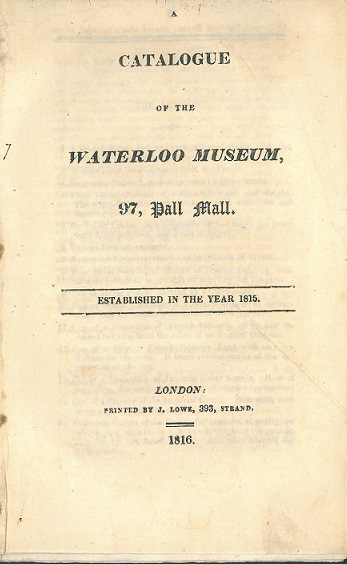The Handel Commemoration held during the last week of May and the first week of June 1784 was the musical and social event of the year. Marking the twenty-fifth anniversary of the composer’s death, the series of three concerts – two of sacred music at Westminster Abbey and one of secular music at the Pantheon – proved so popular that the Westminster Abbey concerts had to be repeated. Those who paid the one guinea entrance fee were treated to one of the “grandest and most magnificent spectacles which imagination can delineate”.

An Account of the Musical Performances in Westminster-Abbey and the Pantheon by Charles Burney (1785) Rare Books q ML 410.H2
The event was recorded in great detail in An Account of the Musical Performances in Westminster-Abbey and the Pantheon… by Charles Burney (1785), a copy of which has been presented to the Library by a former student. The book contains illustrations of the ticket designs and the assembled performers, a plan of the orchestra and lists of those who took part as well as reviews of the concerts. Dedicated to King George III, the book’s erratic page numbering (vii, [1], xvi, 8, *8, 9-20, *19-*24, 21-56, 21, [6], 26-41, [6], 46-90, [5], 94-139, [3] p.) was in part the result of additions and revisions suggested by the King, who showed a keen interest in all matters relating to the Commemoration. With the concerts taking place in the aftermath of the constitutional crisis in which William Pitt took office in place of the Fox-North coalition, the high profile event presented George III with an opportunity to promote a sense of national unity and a healing of the political divide.

View of the Orchestra and Performers in Westminster Abbey
According to Burney, Westminster Abbey was transformed for the event. The staging built for the performers at the west end, rose from seven feet above floor level to an impressive forty feet, where the organ, constructed for Canterbury Cathedral, but being given a trial run, was placed in a gothic frame. Large instruments were assembled to produce enough sound to fill the space and the orchestra had 250 members, with the choir bringing the total number of performers to 522. A Royal Box was built at the east end of the aisle, where there was also seating for the “first personages of the kingdom”, including the organisers, the Directors of the Concerts of Ancient Music, identified by their white wands tipped with gold. Over the course of the concerts, £6,000 was raised for the Fund for the Support of Decay’d Musicians, a charity supported by Handel himself, and £1,000 for Westminster Hospital, whose own charity concert had been displaced by the Commemoration.

List of vocal performers
Coverage in the newspaper and periodical press both in the days leading up to the concerts and in those that followed was unprecedented. There was correspondence concerning retention of the tickets, which included designs by well-known artists and engravers, it was announced that ladies with hats would not be admitted and they were requested to come “without feathers and wearing small hoops, if any”. Reviewing the first concert, the Gentleman’s Magazine could not “in any adequate terms describe the grandeur of the spectacle” the King appearing to be in an “extasy of astonishment” on seeing the sight before him. The Commemoration was widely reported in provincial newspapers, the Hampshire Chronicle also having difficulty in finding the words to describe the sight.

Hampshire Chronicle 7 June 1784 Rare Books Cope per ff 05
Not all of the coverage was so positive. The Universal Magazine suggested that the grandeur of the undertaking was out of proportion to the object, whilst the radical newspaper, Parker’s General Advertiser, dwelt on the vapour which overcame delicate constitutions and the heat which caused many people to faint, something which Charles Burney preferred to put down to the effect of the “choral power of harmonical combinations”.
The success of the Commemoration was such that it was repeated in the following three years and in the early 1790s, by which time there were smaller audiences and, in the era of the French Revolution, more opposition to displays of aristocratic patronage. Nevertheless, it established a tradition of large-scale performances of Handel’s choral works, with Burney’s book providing a record of the first such event.
![Queen Victoria and the Prince of Wales, Queen Victoria by Richard R. Holmes (1897) [Rare Book DA 55A]](https://specialcollectionsuniversityofsouthampton.files.wordpress.com/2018/06/queen-victoria-coronation-1.jpg?w=500)
![Queen Victoria at her coronation, Queen Victoria by Richard R. Holmes (1897) [Rare Book DA 55A]](https://specialcollectionsuniversityofsouthampton.files.wordpress.com/2018/06/queen-victoria-coronation-2.jpg?w=500)
![Queen Victoria, 1838 Queen Victoria by Richard R. Holmes (1897) [Rare Book DA 55A]](https://specialcollectionsuniversityofsouthampton.files.wordpress.com/2018/06/queen-victoria-coronation-3.jpg?w=500)

![Hougoumont, Waterloo [MS 351/6 A4170/7/4]](https://specialcollectionsuniversityofsouthampton.files.wordpress.com/2018/06/ms351_6_a4170_7_4.jpg?w=500&h=303)
![Waterloo subscription, 1815 [MS 61 WP1/487/10]](https://specialcollectionsuniversityofsouthampton.files.wordpress.com/2018/06/ms61_wp1_487_10.jpg?w=378&h=537)


![Lord Louis Mountbatten leaning against the rail of his ship, HMS P31, August 1919 [MB2/N4/18]](https://specialcollectionsuniversityofsouthampton.files.wordpress.com/2018/06/the-ms62_mb2_n4_p35.jpg?w=500)
![Letter from Southampton Football and Athletic Company Limited, wishing Lord Mountbatten a happy Christmas, 18 December 1946 [MB1/L499]](https://specialcollectionsuniversityofsouthampton.files.wordpress.com/2018/06/official-southampton-football-and-athletic-co-ltd-christmas-wishes-letter.jpg?w=500)







![Men's football team, 1953-4 [photo_MS1_7_291_22_4] Men's football team, 1953-4 [photo_MS1_7_291_22_4]](https://live.staticflickr.com/65535/50089268168_f26eed63ef_s.jpg)
![Women's rowing team, 1961-2 [MS1_7_291_22_4] Women's rowing team, 1961-2 [MS1_7_291_22_4]](https://live.staticflickr.com/65535/50090079577_3b7acbde42_s.jpg)
![Men's rugby team, 1953-4 [MS1_7_291_22_4] Men's rugby team, 1953-4 [MS1_7_291_22_4]](https://live.staticflickr.com/65535/50089268523_4f2c587220_s.jpg)
![Women's hockey team, 1953-4 [MS1_7_291_22_4] Women's hockey team, 1953-4 [MS1_7_291_22_4]](https://live.staticflickr.com/65535/50090079692_28114e9c7d_s.jpg)